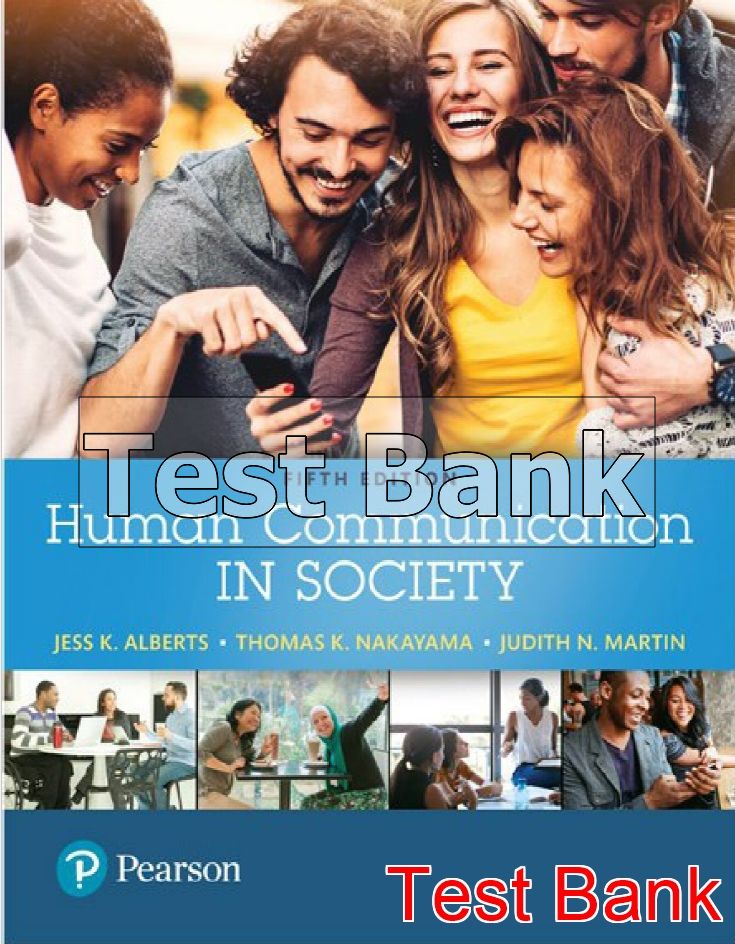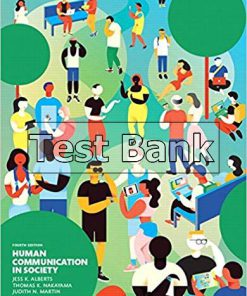Human Communication in Society 5th Edition Alberts Test Bank
$50.00 Original price was: $50.00.$26.50Current price is: $26.50.
Human Communication in Society 5th Edition Alberts Test Bank.
Human Communication in Society 5th Edition Alberts Test Bank

Product details:
- ISBN-10 : 0134553721
- ISBN-13 : 978-0134553726
- Author: Jess Alberts
This is the eBook of the printed book and may not include any media, website access codes, or print supplements that may come packaged with the bound book. For courses in Introduction to Communication An overview of communication that balances individual and social factors Human Communication in Society presents a lively overview of the discipline that engages students in exploring the implications of communication in their daily lives. Providing a balance between theory and application, authors Jess Alberts, Thomas Nakayama, and Judith Martin highlight the tension between individual and societal forces and encourage students to recognize the value of multiple perspectives in understanding communication. The 5th Edition has been thoroughly updated to reflect the latest research and to include expanded coverage of social media and LGBT voices.
Table contents
- PART I UNDERSTANDING HUMAN COMMUNICATION PROCESSES
- Chapter 1 Introduction to Human Communication
- LEARNING OBJECTIVES
- CHAPTER TOPICS
- The Importance of Studying Human Communication
- Critical Thinking: A Key to Successful Communication
- Advantages of Studying Human Communication
- What Is Human Communication?
- Components of Human Communication
- Message Creation
- Meaning Creation
- Setting
- Participants
- Channels
- Noise
- Feedback
- A Model of Human Communication: The Synergetic Model
- Communication Is Transactional
- Communication Is Influenced by Individual Forces
- Communication Is Influenced by Societal Forces
- Communication Is Influenced by Culture
- Communication Is Influenced by Context
- Communication Ethics
- Defining Your Communication Ethic
- Truthfulness
- Sharing or Withholding Information
- Benefit and Harm of Messages
- Absolutism versus Relativism
- Communication Ethics in Practice
- Putting It All Together: Communicating Competently
- SUMMARY
- KEY TERMS
- APPLY WHAT YOU KNOW
- EXPLORE
- Chapter 2 Perspectives on Human Communication
- LEARNING OBJECTIVES
- CHAPTER TOPICS
- Contemporary Approaches to Studying Human Communication
- Paradigms, Theories, and Methods
- The Social Science Approach: Assumptions, Theories, Methods, Ethical Issues, and Strengths and Limitations
- Assumptions
- Theories and Methods
- Ethical Issues
- Strengths and Limitations
- The Interpretive Approach: Assumptions, Theories, Methods, Ethical Issues, and Strengths and Limitations
- Assumptions
- Theories and Methods
- Ethical Issues
- Strengths and Limitations
- The Critical Approach: Assumptions, Theories, Methods, Ethical Issues, and Strengths and Limitations
- Assumptions
- Theories and Methods
- Ethical Issues
- Strengths and Limitations
- A Multifaceted Approach
- Three Perspectives on Communication
- SUMMARY
- KEY TERMS
- APPLY WHAT YOU KNOW
- Chapter 3 Communicating Identities
- LEARNING OBJECTIVES
- CHAPTER TOPICS
- The Importance of Identity
- What is Identity?
- The Individual and Identity
- Identity Development through Communication
- Reflected Appraisals
- Social Comparisons
- Self-Fulfilling Prophecy
- Self-Concept
- Performance of Individual Identity
- The Individual, Identity, and Society
- Racial Identity
- National Identity
- Ethnic Identity
- Gender Identity
- Sexual Identity
- Age Identity
- Social Class Identity
- Disability Identity
- Religious Identity
- Ethics and Identity
- Skills for Communicating about Identities
- SUMMARY
- KEY TERMS
- APPLY WHAT YOU KNOW
- Chapter 4 Communicating, Perceiving, and Understanding
- LEARNING OBJECTIVES
- CHAPTER TOPICS
- The Importance of Perception
- What Is Perception?
- Selection
- Organization
- Cognitive Representation
- Categorization
- Interpretation
- Frames
- Attribution
- Perception and the Individual
- Physical Differences
- Personality and Individual Characteristics
- Emotional State
- Outlook
- Knowledge
- Cognitive Complexity
- The Individual, Perception, and Society
- The Role of Power
- The Role of Culture
- The Role of Social Comparison
- Ethnocentrism
- Stereotypes
- Prejudice
- The Role of Historical Time Period
- Social Roles
- Ethics and Perception
- Improving Your Perception Skills
- SUMMARY
- KEY TERMS
- APPLY WHAT YOU KNOW
- EXPLORE
- PART II DEVELOPING EFFECTIVE HUMAN COMMUNICATION SKILLS
- Chapter 5 Verbal Communication
- LEARNING OBJECTIVES
- CHAPTER TOPICS
- The Importance of Verbal Communication
- What Is Verbal Communication? Functions and Components of Language
- Functions of Language
- Components of Language
- Phonology: Sounds
- Syntax: Rules
- Semantics: Meaning
- Pragmatics: Language in Use
- Speech Acts
- Conversational Rules
- Contextual Rules
- The Individual and Verbal Communication: Influences
- Gender
- Age
- Regionality
- Ethnicity and Race
- Education and Occupation
- The Individual, Verbal Communication, and Society: Language, Perception, and Power
- Language and Perception
- Language and Power
- Power and Words
- Power and Accent
- Power and Identity Labels
- Ethics and Verbal Communication
- Hate Speech
- Confirming and Disconfirming Communication
- Improving Your Verbal Communication Skills
- “I” Statements
- Become Aware of the Power of Language
- SUMMARY
- KEY TERMS
- APPLY WHAT YOU KNOW
- Chapter 6 Nonverbal Communication
- LEARNING OBJECTIVES
- CHAPTER TOPICS
- The Importance of Nonverbal Communication
- What Is Nonverbal Communication?
- Nonverbal Communication and the Individual
- Influences on Nonverbal Communication
- Nonverbal Codes
- Kinesics
- The Body
- The Face
- Paralinguistics
- Voice Qualities
- Vocalizations
- Time and Space
- Chronemics
- Proxemics
- Haptics
- Appearance and Artifacts
- The Functions of Nonverbal Messages
- Communicating Information
- Regulating Interaction
- Expressing and Managing Intimacy
- Establishing Social Control
- Signaling Service-Task Functions
- The Individual, Nonverbal Communication, and Society
- Nonverbal Communication and Power
- Nonverbal Communication, Prejudice, and Discrimination
- Ethics and Nonverbal Communication
- Improving Your Nonverbal Communication Skills
- SUMMARY
- KEY TERMS
- APPLY WHAT YOU KNOW
- EXPLORE
- Chapter 7 Listening and Responding
- LEARNING OBJECTIVES
- CHAPTER TOPICS
- The Importance of Listening
- What Is Listening? Four Stages
- Listening and the Individual: Influences and Barriers
- Influences on Listening
- Listening Styles
- Action-Oriented Listening Style
- Content-Oriented Listening Style
- People-Oriented Listening Style
- Time-Oriented Listening Style
- Individual Identity Characteristics
- Gender
- Age
- Nationality
- Barriers to Listening
- Physical and Physiological Barriers
- Psychological Barriers
- Conflicting Objectives
- Poor Listening Habits
- The Individual, Listening, and Society: Hierarchy, Contexts, and Community
- Social Hierarchy
- Social Status
- Physical Appearance
- Vocal Cues
- Listening in Context
- Listening and Community
- Ethics and Listening
- Improving Your Listening Skills
- Identify Poor Habits
- Strive for Mindful Listening
- SUMMARY
- KEY TERMS
- APPLY WHAT YOU KNOW
- PART III COMMUNICATING IN CONTEXT
- Chapter 8 Communication across Cultures
- LEARNING OBJECTIVES
- CHAPTER TOPICS
- The Importance of Intercultural Communication
- Increased Opportunities for Intercultural Contact
- Enhanced Business Effectiveness
- Improved Intergroup Relations
- Enhanced Self-Awareness
- What Is Intercultural Communication?
- Border Dwellers through Travel
- Border Dwellers through Socialization
- Border Dwellers through Relationships
- Intercultural Communication and the Individual: Cultural Values
- The Influence of Cultural Values on Communication
- Individualism and Collectivism
- Preferred Personality
- Human Nature
- Human–Nature Relationship
- Power Distance
- Long-Term versus Short-Term Orientation
- Indulgence versus Restraint
- The Individual, Intercultural Communication, and Society: Politics, History, and Power
- Political and Historical Forces
- Intercultural Communication and Power
- Ethics and Intercultural Communication
- Improving Your Intercultural Communication Skills
- Increase Motivation
- Increase Your Knowledge of Self and Others
- Avoid Stereotypes
- Strive for Empathy
- Navigating the Borderlands
- SUMMARY
- KEY TERMS
- APPLY WHAT YOU KNOW
- Chapter 9 Communicating in Close Relationships
- LEARNING OBJECTIVES
- CHAPTER TOPICS
- The Importance of Communication in Close Relationships
- Close Relationships and the Individual
- Theories of Relationship Development
- Attraction Theory
- Proximity
- Attractiveness
- Similarity
- Uncertainty Reduction Theory
- Predicted Outcome Value Theory
- Social Exchange and Equity Theories
- Models of Relationship Development
- Stage Models of Relationship Development
- Turning Point Model of Relationship Development
- Communicating in Friendships and Romantic Relationships
- Initiating Relationships
- Initiating Romantic Relationships
- Initiating Friendships
- Maintaining Relationships
- Maintaining Romantic Relationships through Communication
- Maintaining Friendships through Communication
- Ending Relationships
- Reasons and Strategies for Courtship Dissolution
- Reasons and Strategies for Friendship Dissolution
- Aversive Communication Behaviors in Relationships
- Deception
- Jealousy
- Interpersonal Violence
- Sexual Coercion
- The Individual, Relationship Communication, and Society
- Ethics and Close Relationships
- Improving Your Relationship Communication Skills
- SUMMARY
- KEY TERMS
- APPLY WHAT YOU KNOW
- EXPLORE
- Chapter 10 Small Group Communication
- LEARNING OBJECTIVES
- CHAPTER TOPICS
- The Importance of Small Group Communication
- Reasons to Study Small Group Communication
- A Fact of Life
- Enhanced College Performance
- Enhanced Career Success
- Enhanced Personal Life
- Advantages and Disadvantages of Group Work
- What Is Small Group Communication?
- A Small Number of People
- A Common Purpose
- A Connection with Each Other
- An Influence on Each Other
- Small Group Communication and the Individual: Roles
- Types of Communication Roles
- Task Roles
- Relational Roles
- Individual Roles
People also search:
human communication in society 5th edition pdf reddit
human communication in society 5th edition
4 types of human communication
5 impacts of communication on society and the world
human communication facts
Instant download after Payment is complete
You may also like…
Business Communication
Excellence in Business Communication Canadian 5th Edition Thill Test Bank




















